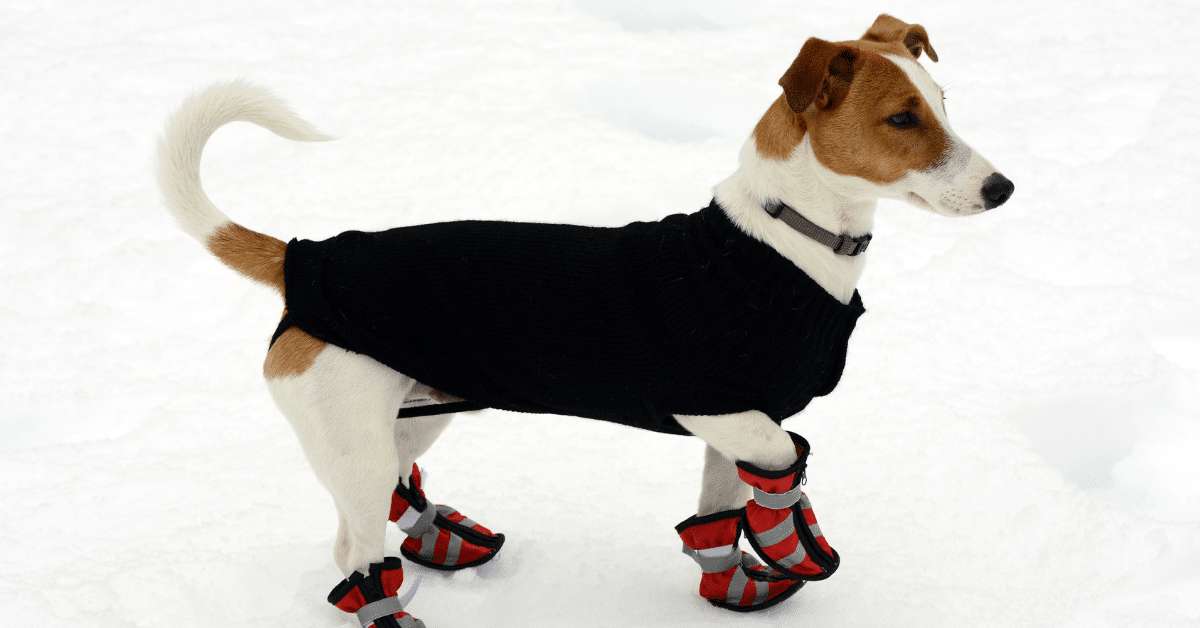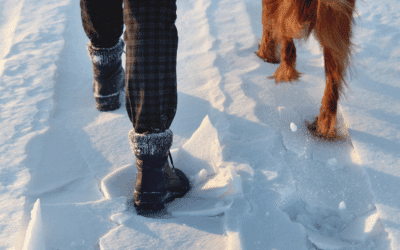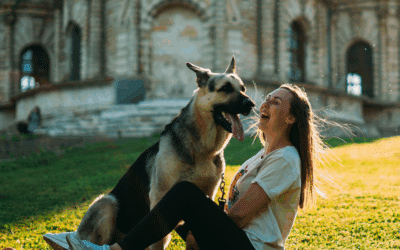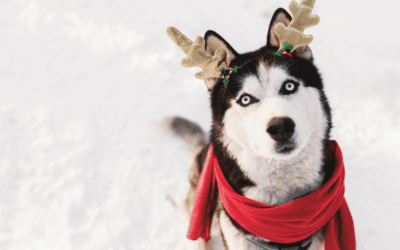Kate’s K9 Pet Care proudly provides dog walking, cat sitting, small animal pet care, pet taxi services, “Almost Overnight” pet care, and convenient pet supply delivery. To see where we currently operate, please visit our Service Area Page .
As a professional pet caregiver in Northern Virginia and Southern Maryland, I’ve seen firsthand how our local weather can be unpredictable. One day it’s mild and sunny, and the next, we’re dealing with icy sidewalks, rock salt, and freezing temperatures. These sudden cold snaps can be tough on a dog’s paws.
Many pet parents ask me whether dog snow boots or booties are truly necessary. It’s a great question, and the answer isn’t always straightforward. My goal with this guide is to simplify the decision for you and offer practical tips to keep your pup’s paws safe, warm, and comfortable all winter long.
How Winter Weather Affects a Dog’s Paws
A dog’s paws are naturally tough, but they aren’t indestructible. Winter conditions can pose several challenges. The combination of ice, snow, and de-icing chemicals like rock salt can lead to dryness, cracking, and painful irritation on their paw pads. If you’ve ever had cracked skin on your hands in winter, you can imagine how uncomfortable this would be for your dog.
Another common issue I see is the formation of ice balls between a dog’s toes. Snow melts from their body heat and then refreezes into clumps of ice, which can pull on their fur and cause discomfort or even pain. You may notice your dog stopping to lick or chew at their paws, which is a clear sign something is wrong.
Book services online in just a couple minutes.
It’s also interesting to note that dogs often react differently to various surfaces. One dog might not mind a slippery sidewalk, while another becomes anxious. Front paws and rear paws can also handle cold differently. Understanding your dog’s unique reactions to frozen ground, sharp rocks hidden under snow, and slick surfaces is the first step in providing the right protection.
When Dogs Should Wear Boots in Winter
So, when are boots a good idea? I recommend them in several specific situations, especially for dogs in our area. Dogs wear boots to create a necessary barrier between their sensitive pads and harsh elements.
Consider using boots for:
- Long walks on salted sidewalks: De-icing chemicals can cause chemical burns and severe dryness.
- Frozen or rough terrain: Frozen grass and rough trails can be abrasive.
- Extreme weather: During ice storms or days with a very low windchill, boots provide essential insulation.
- Dogs with sensitive feet: Some breeds or individual dogs naturally have thinner or more sensitive paw pads.
- Senior dogs: Older dogs often struggle with traction on icy surfaces, and boots can prevent dangerous slips and falls.
- Pups recovering from injuries: If your dog has a cut or scrape on their paw, boots keep the wound clean and protected.
Types of Dog Boots and Dog Booties
The world of dog boots and dog booties can be overwhelming. Here’s a simple breakdown of the most common styles to help you choose.
- Rubber Boots: These are like little rain boots for your dog. They are great for wet, icy, or slushy days because they are waterproof and offer good traction. The downside is they can be less breathable.
- Dog Socks: Best for indoor use, these provide traction on slippery hardwood floors. They are perfect for senior dogs who need extra grip around the house but aren’t suitable for outdoor winter conditions.
- Soft Shield Boots: These are lightweight and flexible, making them a good choice for dogs who hate the feel of bulkier shoes. They offer basic protection from salt and cold without feeling too restrictive.
- Suspender Boots: Does your dog have a talent for kicking off booties? These clever designs attach to suspenders that go over your dog’s back, making them nearly impossible to lose.
- Dog Shoes with Thicker Soles: These are heavy-duty options, ideal for both rugged winter walks and protecting paws from hot pavement in the summer. They offer maximum durability and protection.
When you’re shopping, pay attention to features like waterproofing, secure Velcro straps, overall durability, breathability for comfort, and good traction on the soles.
How to Choose the Best Dog Boots
Finding the best dog boots comes down to fit and function. An ill-fitting boot can cause more problems than it solves, leading to rubbing, blisters, or just falling off mid-walk.
Here is my checklist for choosing the right pair:
- Measure for a Snug Fit: Most brands have sizing guides. Measure your dog’s paw width while they are standing, as their paw will spread out with weight on it. The boot should be snug but not tight.
- Look for Lightweight Materials: A heavy, clunky boot will make it difficult for your dog to walk naturally.
- Check the Traction: Look for soles with good grip, like the popular Grip Trex style, to prevent slips on ice.
- Consider the Sole Thickness: For rough terrain or extreme temperatures, a thicker sole is better. For simple sidewalk walks, a thinner, more flexible sole might be more comfortable.
- Test the Fasteners: Quality Velcro or secure straps are essential. You don’t want to be constantly stopping to adjust or put a boot back on.
- Stick to Trusted Brands: Brands like Canada Pooch are known for durability and thoughtful design.
Popular Dog Boots For Your Furry Friend
- Ruffwear Polar Trex Dog Boots: Built for wet, snowy, and icy winter walks and hikes, these boots have thick soles for extra traction. Buy here
- Muttluks MuttGators: Designed for deep snow, these boots come with leg coverings and three fastening straps for a secure fit. Buy here
- Wagwear Wagwellies Mojave: A top-rated dog boot, perfect for small and large dogs alike, offering excellent protection and comfort. Buy here
- Ruffwear Summit Trex Dog Shoes: All-season paw protection with durable soles and a secure fit. Buy here
- Mountain Ridge Sled & Pet Dog Booties: Waterproof, non-slip, and gripped boots designed for sled and active pet dogs. Buy here
- Ruffwear Grip Trex Boots: High-performance boots with rugged outsoles for hiking and winter adventures. Buy here
- QUMY Dog Boots Waterproof Shoes: Affordable and waterproof boots with reflective straps for visibility and safety. Buy here
Are Dog Shoes Helpful Indoors Too?
Yes, dog shoes and socks can be incredibly useful inside the house. Many modern homes in our area have hardwood or laminate flooring, which can be slippery for dogs, especially seniors. Indoor booties with rubber grips on the bottom can give an older dog the confidence to move around without fear of falling.
They are also beneficial for dogs recovering from paw injuries or surgery, as they can keep the area clean and prevent licking. On rainy days, they can also help prevent your dog from tracking muddy paw prints all over your clean floors.
Tips for Helping Your Pup Adjust to Dog Booties
Let’s be honest: most dogs are not immediate fans of wearing dog booties. The key is to introduce them slowly and positively.
- Let them sniff: Before you even try to put them on, let your dog investigate the new booties.
- Start with short durations: The first time, put one bootie on for just a minute or two, then take it off and give them a treat. Gradually work your way up to all four.
- Reward generously: Use high-value treats to create a positive association.
- Practice indoors: Let them get used to the feel by walking around the house for a few minutes. Many dogs will walk with high steps at first—this is normal!
- Check for rubbing: After each wear, take the booties off and inspect your dog’s paws and legs for any signs of irritation or rubbing.
What to Use if Your Dog Refuses Boots
Some dogs will never accept wearing boots, and that’s okay. You still have great options for protecting their paws.
- Paw Balms or Waxes: These products create a semi-permeable barrier on the paw pads, protecting them from salt and ice. Apply it right before you head out.
- Baby Socks with Traction: In a pinch for indoor use, non-slip baby socks can provide some grip for senior dogs.
- Shorter, More Frequent Walks: On brutally cold days, multiple short walks may be better than one long one.
- Wipe Paws Immediately: As soon as you get home, use a warm, damp cloth to wipe your dog’s paws. This removes salt, chemicals, and ice.
Summer Protection: Dog Snow Boots Aren’t Just for Winter
It’s worth noting that paw protection is a year-round concern. During hot weather, pavement can reach dangerous temperatures and burn a dog’s sensitive pads. Lightweight, breathable dog boots are perfect for protecting paws during summer walks, beach days, or hikes on rough trails.

How We Watch Out for Your Dog’s Paws
As part of our service at Kate’s K9 Pet Care, your dog’s safety and comfort are my top priorities. We are always mindful of their paws during our walks.
Our team checks paws before and after every walk, especially in extreme weather. We adjust our walking routes to avoid heavily salted sidewalks or overly rough terrain whenever possible. If we notice any signs of irritation, redness, or cracking on your dog’s paw pads, we will let you know immediately. With your permission and supplies, we are happy to apply paw balm before or after walks. This dedication to cold-weather, hot-weather, and rainy-day adjustments provides peace of mind for the busy families, travelers, and commuters we serve.
Protecting Your Pup Through Every Season
Ultimately, every dog is different. Some take to winter boots immediately, while others prefer the freedom of bare paws. What matters most is that you’re aware of the risks from extreme weather conditions—whether it’s icy sidewalks, hot surfaces in summer, or slippery floors indoors—and take steps to keep your furry family member safe, happy, and comfortable.
Choosing the right fit for your dog’s feet and legs goes a long way in making sure they stay cool, warm, and protected through every season. The best boots for your pack are the ones your dog will wear willingly—so it’s smart to gradually increase wear time, always using a leash for those first few walks. Not all boots or dog gear are alike; sometimes other boots designed for slippery surfaces or specific climates make the difference in keeping paws warm and ensuring your dog is comfortable.
Paying attention to your dog’s comfort level and adjusting to their needs is the best thing you can do as a loving pet owner. With the right gear, your dog will stay ready for every adventure, year-round.






